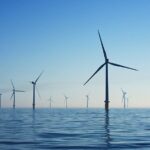Republican Governor Glenn Youngkin’s administration has filed a letter with the State Corporation Commission asking the regulators to approve the Dominion Energy Virginia application to build a 176-turbine Coastal Virginia Offshore Wind (CVOW) project.
The letter was on Department of Energy letterhead and signed by that agency’s director, John Warren, a holdover from the Democratic Ralph Northam administration.
During and after the 2021 campaign, Youngkin was critical of the 2020 Virginia Clean Economy Act (VCEA) that mandated SCC approval of the project, slated to cost just under $10 billion. He expressed a desire to protect consumers from rising energy costs. But he and his staff took no role in the 2022 legislative efforts to repeal VCEA or restore more SCC authority over costs, bills which passed in the House of Delegates but failed in a Senate committee stacked with Democrats.
He is now off the sidelines. Youngkin’s support for the project assumes it can become an economic boon to the state. His department director wrote:
Offshore wind presents an opportunity to introduce a new industrial sector to Virginia’s economic future. As an emerging industry in the US, activity associated with hosting large sections of the offshore wind supply chain during the development of this project can validate Virginia’s potential to host a U.S. East Coast supply chain hub. Investment to establish the offshore wind industry in Virginia should be viewed within the wider context of the overall benefit the industry offers.
States that can rapidly advance their local offshore wind industry are likely to have a “first-mover” advantage in capturing the jobs and economic activity associated with the supply chain required to support the 30 GW of offshore wind expected to be developed along the East Coast by 2030.
Virginia Energy also strongly supports the need to protect the interests of ratepayers. To that end, Virginia Energy recommends the Commission’s order in this proceeding include additional reporting requirements and a performance guarantee in the event that it approves the project.
Whether and how to structure such reporting requirements or performance guarantees was reportedly the focus of the SCC’s hearings on the application last week. Virginia Mercury’s report is the most comprehensive. Unfortunately, I was otherwise occupied with what they call “pressing personal business” for the period.
None of the various parties to the case, not even the Office of Consumer Counsel under Attorney General Jason Miyares (R), has asked the Commission to reject the application. The only grounds to do so, thanks to VCEA, would be a finding that the projected cost will exceed a specified levelized cost of energy (LCOE) of $125 per megawatt hour. That cost cap was designed by Dominion and inserted in VCEA.
The SCC staff in its analysis laid out various scenarios where the initial construction cost projections escalate, or performance of the final project fails to meet its promised capacity or availability factors, and the $125 per megawatt hour ceiling is breached. But the staff then also signed a stipulation with Dominion and basically agreed that what is on paper for the application is below the target and is “reasonable and prudent pursuant to governing law.” That final qualifier recognizes that the VCEA is not the standard regulatory approach, but it is now Virginia’s “governing law.”
Other parties, including Attorney General Miyares and some of the environmental groups, did not sign the stipulation, but any united front against Dominion in front of the judges has dissolved. The file is now full of comments pro and con, more than probably any previous case, but the Youngkin Administration position will be noticed, especially the call for a performance guarantee.


Leave a Reply
You must be logged in to post a comment.